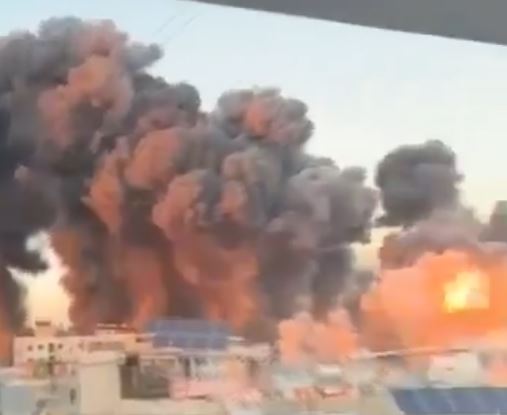The Israel Defense Forces (IDF) have confirmed that the Israeli Air Force conducted an airstrike on Hezbollah’s main headquarters located in the Dahiyeh suburb of Beirut, a known stronghold for the militant group. IDF Spokesman Rear Adm. Daniel Hagari stated that the facility was constructed beneath civilian buildings.
Hagari did not clarify whether Hezbollah leader Hassan Nasrallah was a target or present at the site during the strike. He also indicated that there would be no changes to safety guidelines for Israeli civilians at this time.
Also Read: Thousands of Syrian Refugees Flee Lebanon Amid Escalating Conflict
In recent weeks, Israel has reportedly eliminated many senior leaders of Hezbollah. Footage from Lebanese media has emerged, showing the scale of the strikes.
Israeli Prime Minister Benjamin Netanyahu confirmed late Thursday that Israel “shares the aims” of a US-led initiative for a temporary ceasefire with Hezbollah, following significant criticism from his coalition for his initial private agreement to the plan. The Prime Minister’s Office (PMO) issued a statement clarifying Israel’s stance after the US and France reported that Israel had indicated support for the proposed 21-day truce.
Israeli and American officials met on Thursday to discuss the initiative, focusing on strategies to enable safe returns for displaced residents along the northern border. The PMO stated that discussions will continue in the coming days, emphasizing the shared goal of providing security for local populations.
This ceasefire proposal comes after a week of intense Israeli military operations that have severely impacted Hezbollah’s leadership and capabilities, coinciding with a series of explosions linked to Israeli operations targeting Hezbollah communications.
The initiative also aims to facilitate a hostage release and a ceasefire agreement in Gaza, where Israel is currently engaged in conflict with Hamas, and to negotiate Hezbollah’s withdrawal from areas near Israel’s northern border in accordance with a UN Security Council resolution.
“Due to a lot of misreporting around the US-led ceasefire initiative, it is important to clarify a few points,” the PMO stated. “Israel shares the aims of enabling people along our northern border to return safely and securely to their homes,” reaffirming its military objectives against Hezbollah.
During a flight to New York for the UN General Assembly, Netanyahu denied having approved the ceasefire proposal, despite Western diplomatic sources indicating that he had been involved in crafting the joint US-French announcement.
Upon arrival in New York, Netanyahu reiterated Israel’s commitment to continue operations against Hezbollah. “We are continuing to strike Hezbollah with full force,” he declared, underscoring that the primary goal remains the secure return of residents in northern Israel.
Strategic Affairs Minister Ron Dermer engaged in discussions with US officials, including Secretary of State Antony Blinken, who emphasized the need for a diplomatic resolution to the conflict. Blinken warned that further Israeli escalation could hinder the goal of returning civilians to their homes.
Meanwhile, at the UN, Lebanese Foreign Minister Abdallah Bouhabib called for an immediate ceasefire, cautioning that ongoing violence could destabilize regional peace and security.
Since October 8, clashes between Hezbollah and Israeli forces have resulted in significant casualties, including 26 civilian deaths and 22 military fatalities on the Israeli side, while Lebanon reports over 630 deaths, predominantly among civilians, since Israel intensified its airstrikes on Monday.



